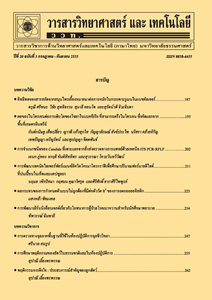ปริมาณสปอร์ของรา Aspergillus, Cladosporium และ Penicillium ชักนำให้เกิดโรคหอบหืดอย่างมีศักยภาพในนักเรียนอายุ 10-15 ปี
Main Article Content
Abstract
บทคัดย่อ
การวิจัยนี้มีวัตถุประสงค์เพื่อศึกษาปริมาณชนิดของรา Aspergillus, Cladosporium และ Penicillium ภายในห้องเรียน ที่อาจชักนำให้เกิดโรคหอบหืดในนักเรียนที่อยู่ในช่วงอายุ 10-15 ปี ของโรงเรียน A, B และ C โดยการใช้เครื่องเก็บตัวอย่างจุลชีพ รุ่น Microflow alfa และวิธีการป้ายพื้นผิว (swab) ในแต่ละวันของสัปดาห์ และอาหารเลี้ยงราที่ใช้ คือ malt extract agar (MEA) ผลการศึกษาปริมาณของราทั้ง 3 ชนิด โดยวิธีการใช้เครื่องเก็บตัวอย่างจุลชีพ เมื่อเปรียบเทียบในแต่ละห้องเรียน และเปรียบเทียบในแต่ละโรงเรียน พบว่าไม่มีความแตกต่างกัน แต่เมื่อเปรียบเทียบปริมาณราในแต่ละวัน มีความแตกต่างกันทางสถิติโดยใช้การวิเคราะห์ความแปรปรวนทางเดียว ที่ระดับนัยสำคัญ 0.05 ผลการวิเคราะห์ปริมาณราทั้ง 3 ชนิด โดยเฉลี่ยพบว่าโรงเรียน A, B และ C มีปริมาณราเฉลี่ย 8.11±0.99, 7.28±1.09 และ 7.03±1.43 CFU/m3 ตามลำดับ นักเรียนที่มีอาการของโรคหอบหืดขณะอยู่ที่โรงเรียน A, B และ C คิดเป็นร้อยละ 1.8, 1.9 และ 1.1 ตามลำดับ นอกจากนี้ยังมีความสัมพันธ์ระหว่างปริมาณราก่อโรคและจำนวนนักเรียนที่มีอาการของโรคหอบหืดขณะอยู่ที่โรงเรียน (r= 0.75, p < 0.05) แสดงว่าปริมาณราก่อโรคอาจเป็นปัจจัยเสี่ยงที่ชักนำให้เกิดอาการของโรคหอบหืดในนักเรียน ผลการวิจัยนี้อาจใช้เป็นแนวทางปรับปรุงคุณภาพอากาศในห้องเรียนให้ปริมาณราในอากาศลดลง ซึ่งอาจช่วยลดอาการของโรคหอบหืดในนักเรียนได้
คำสำคัญ : ปริมาณรา; โรคหอบหืด; โรคภูมิแพ้; นักเรียน; โรงเรียน
Abstract
This study was to investigate spore concentration of Aspergillus, Cladosporium and Penicillium in classrooms potentially could induce to cause asthma disease in students aged 10-15, in schools A, B and C. By using microbial air collector version Microflow alfa and surface swab were used to collect spores for counting, in each day of the week, and fungal medium used malt extract agar (MEA) was as medium culture. Results showed that no significant differences between the amount of 3 fungal species in each classrooms and schools. The amount of fungi differed significantly in each day as determined by one-way analysis of variance at 0.05 levels. The average amounts of 3 fungal species in the schools A, B and C were 8.11±0.99, 7.28±1.09 and 7.03±1.43 CFU/m3,respectively. Student showing asthma symptoms while daying at school A, B and C were 1.8, 1.9 and 1.1 %, respectively. Furthermore, there was also a correlation between the amount of fungi and the number of student showing of asthma symptoms while staying at the school (r=0.75, p < 0.05). This indicated that the amounts of fungi may be a risk factor to potentially induce asthma symptoms in students. The result from this study could be guideline to improve the air quality in classrooms so that the amount of airborne fungi could be reduced and asthma disease in students might also be decreased.
Keywords: concentration of fungi; asthma disease; allergies disease; student; school


